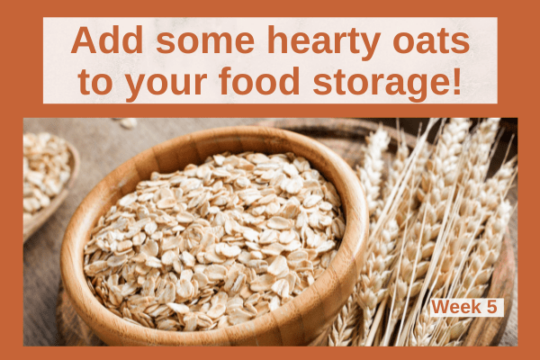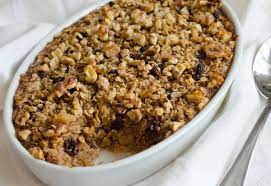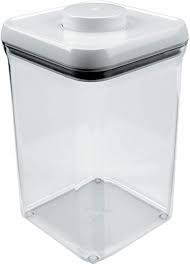Preparedness Challenge Week 5
Welcome to the fifth Preparedness Challenge blog post for 2022. This week’s preparedness challenge is to add oats to your storage. The most common form of oats is oatmeal.
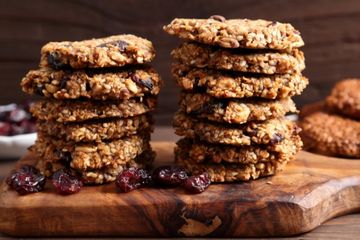
Oats are a versatile grain, and besides making a satisfying cooked breakfast cereal, they make delicious cookies, pancakes, muffins, apple crisps, granola, granola bars, and much more. Oats can also be milled into gluten-free flour and are a good binder in meatballs and as a coating for fried foods.
Four Different Kinds of Oats
WHOLE GRAIN OATS
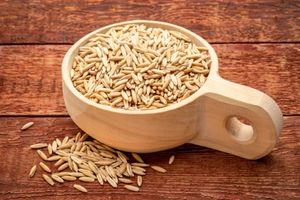
Whole grain oats with the husk (hull) removed are called oat groats, and they look a lot like whole wheat kernels. Cooked groats can be used as a hearty breakfast cereal, as a side dish in place of rice, or to add texture to salads and other dishes. They can also be ground into gluten-free oat flour.
STEEL CUT OATS
Steel cut oats, sometimes called Irish or Scottish oats, make a nourishing and satisfying breakfast cereal. They are made when oat groats are cut into two or three small pieces by mills using fast-moving steel blades. They may be regular-cooking or quick-cooking, and even come in individual, pre-sweetened packets.
OATMEAL
Oatmeal is made by lightly steaming oat groats and putting them through a roller mill. The thickness of the oat flakes determines how fast the oatmeal cooks and the texture of the cooked cereal. Oatmeal comes as quick oats, regular rolled oats, or extra-thick oats. Instant oats are precooked, dried, and rolled extra thin and cook the fastest.
You can flake your own oats using a stand-alone oat flaker or a flaker attachment available for some heavy-duty mixers.
OAT FLOUR
Oat flour can be ground from oat groats using a grain mill or made from oatmeal or steel cut oats in a high-powered blender or food processor. Oat flour can be used for baking, but because it’s less dense and does not contain gluten, it doesn’t transfer one for one in recipes calling for wheat flour. Oat flour is gluten-free but contains avenin, a protein that some people are sensitive to.
Why Is Oatmeal Important in Your Food Storage?
OATMEAL IS SIMPLE TO USE AND EASY TO REPLENISH
Oatmeal is an everyday food that is a terrific food to store for a crisis or emergency. It can be used in a variety of ways, is widely available, and stores well. Keep track of how much oatmeal you use by writing the dates on the storage containers and monitoring your use. Keep a marker handy in your food storage area for easy labeling.
REPLENISH WHAT YOU USE
If you want to increase the amount of oatmeal in your storage, start by doubling the amount of oatmeal you normally have on hand. When you have depleted half your storage, then replenish it. If you do this, you will always have an up-to-date supply of oatmeal. For an even higher level of preparedness, increase the amount you store to three or four times what you normally have on hand, replenishing it ever so often as you use it. You can use this simple rotation system with other products you use as well.
OATMEAL IS EASY TO PREPARE
Oatmeal or steel cut oats can be cooked on the stove, in a microwave, overnight in a thermos, in a rice cooker, in a pressure cooker or multi-cooker. And for instant oatmeal all you do is add hot or boiling water and let it sit a minute–or just use the microwave. If you have reluctant oatmeal eaters, try different cooking methods. Try using less water for a crunchier cereal. And don’t forget to add a bit of salt. Jazz it up with fresh or dried fruit or chopped walnuts. Or try making Amish baked oatmeal! There are many variations of this homey comfort dish.
FAVORITE OATMEAL TOPPINGS
You might want to keep a stash of oatmeal toppings in your pantry to liven-up oatmeal and to add a bit of variety and to pack in more nutrients. Here’s a list of our favorites:

- Raisins, craisins, dates
- Dried apple and peach slices, snipped into chunks
- Walnuts or almonds, coarsely chopped
- Sliced bananas
- Fresh or dried blueberries
- Canned applesauce and peaches
- Flax and chia seed
- Brown sugar and butter or cream (yes, decadent but delicious)
OATS ARE NUTRITIOUS
Oats cannot be discussed without mentioning how whole-grained nutritious they are! They are a good source of vegetable protein, vitamins and minerals, antioxidants, and fiber. Oatmeal is famous for its tendency to keep arteries unclogged and to help with digestion. Compared to other carbohydrates, oats are lower on the glycemic index.
How Much Oatmeal Should You Store?
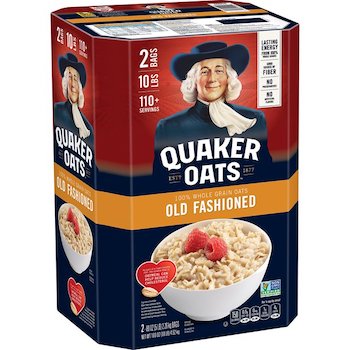
A serving of oatmeal is about a half cup of dry oatmeal, or one and a half ounces. There are close to ten servings in a pound of oatmeal. To keep it simple, add ten pounds of oatmeal to your food storage this week. These amounts will give you approximately ten pounds:
- 1 10-pound double pack
- 4 42-ounce canisters
- 160 packets of instant oatmeal
You may want to purchase part in canisters or double packs and part as boxes of oatmeal packets. And of course, you can always add more, or less, depending on your circumstances and preferences.
If a family of four eats oatmeal three times a week, in two months they will use about 100 servings, or ten pounds of oatmeal.
To keep it simple, add ten pounds of oatmeal to your pantry!
How Much Does a Serving of Oatmeal Cost?
Oatmeal is marketed in various forms. The most economical is plain oatmeal, either regular or quick. Oatmeal can cost as little as ten cents a serving. You will pay more if it is packaged in cans or buckets and more for instant oatmeal in little packets. And you will pay a lot more for small packages of oatmeal if they are part of a food storage plan in a bucket. There is very little difference between the quality of the oatmeal of national brands and that of store brands, but store brands cost less.
Should You Buy Instant Oatmeal Packets for Storage?
PROS
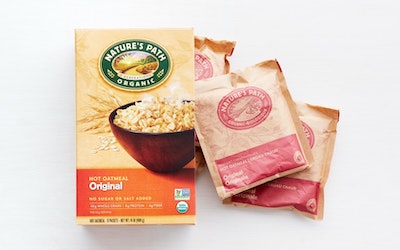
- Oatmeal packets are convenient. They are easy and quick to prepare. This could be important in an emergency.
- The oatmeal in packets usually has added fruit and sugar which makes it taste good. This is a plus if you are trying to feed children. Kids also like picking out their own flavors.
- Oatmeal packets are portable and easy to take with you, if necessary.
- The shelf life for packets is one to two years if stored properly in an airtight container in a dry, dark, and cool environment, which is comparable to other forms of oatmeal.
CONS
- Serving sizes are small. Instant oatmeal packets are two-thirds the serving sizes of other types of oatmeal.
- Flavored oatmeal packets can be high in added sugar. A typical flavored packet has 12 grams of added sugar, which is about one tablespoon in only a third cup of oatmeal. They may also have artificial flavoring and other added chemicals. Check the label.
- Oatmeal packets are significantly more expensive than other ways to buy oatmeal. They cost more than twice as much as oatmeal in 42-ounce canisters and almost four times as much as oatmeal in 10-pound double-packs.
- The packets are made exclusively for eating as cereal and don’t work well for making cookies, bread, etc.
- Instant oatmeal is not as textured as regular oats and the flavor is milder, some say bland.
Try Making Your Own Instant Oatmeal Packets
If you want the convenience of instant oatmeal packets, but without the extra cost, with less sugar, and with more interesting add-ins, try making your own instant oatmeal packets. Begin by mixing the following ingredients in a large bowl:
- 8 cups of quick oats
- 2 cups of quick oats, coarsely chop in a food processor
- 1 cup of powdered milk
- ½ cup of sugar
- 2 teaspoons salt
- 1 tablespoon cinnamon, optional
Package ½ cup of oatmeal mix into snack-size plastic bags. Store bags in sealed canister. Use within one year.
To serve, add raisins, dates, or other dried fruits as desired. Mix contents with ½ cup of boiling water and let stand for five minutes or microwave for about one minute.
What Is the Best Way to Store Oatmeal?
WHAT YOU SHOULD KNOW ABOUT THE SHELF LIFE OF OATMEAL
- Over time, the oil in oatmeal will oxidize and become rancid.
- Rancid oatmeal has a noticeable unpalatable “off” taste and smell.
- The vitamins in oatmeal lose their potency over time.
- Oatmeal will become moldy if it gets damp.
- Like all grains, oatmeal is susceptible to insect infestation and rodents.
For long term storage of oatmeal, the easiest and best solution is to purchase oatmeal already packaged in #10 cans or in mylar bags with oxygen absorbers.
Because of my own experience and conflicting recommendations by “experts”, I find that determining a precise shelf-life for oatmeal is difficult. I’ve listed some basic things about the shelf life of oatmeal so you can make your own decisions about storing it.
TIPS FOR STORING OATMEAL
- Storage life is optimized if oatmeal is stored in a cool, dry, and dark location.
- Oatmeal has a longer shelf life if stored below 70 degrees, and even longer below 60 degrees.
- Oatmeal left in its original paper or cardboard packaging has a storage life of about one-and-a-half to two years.
- Flavored instant oatmeal in small individual packets has a shorter shelf life than regular oatmeal.
- Oatmeal stored in airtight containers in a cool place has a shelf life of two to three years.
- Oatmeal stored in #10 cans or Mylar bags with oxygen absorbers has a shelf life of eight to ten years.
CONTAINERS FOR STORING OATMEAL
Store oatmeal in your pantry in the packaging you purchased it in for a year to eighteen months. For a longer shelf life, store it in an airtight containers such as the OXO Good Grips POP Container. Ideally, use and replenish oatmeal within two to three years.
For long term storage of oatmeal, the easiest and best solution is to purchase oatmeal already packaged in #10 cans or mylar bags with oxygen absorbers. For optimum storage life, store containers in a cool, dry place. It may be possible to leave oatmeal in cans for up to thirty years, and although it may be edible, the overall quality and nutritional value will likely be diminished.
You’ll see links on this site associated to various products, services, etc. Assume any link you see on this site is an affiliate link, which means if you click on it, CrisisPreparedness.com may receive compensation.

Find out more about storing foods in Crisis Preparedness Handbook, Third Edition (2020). If you don’t already have a copy, you can find it here on my website CrisisPreparedness.com. Or, find it on Amazon.
